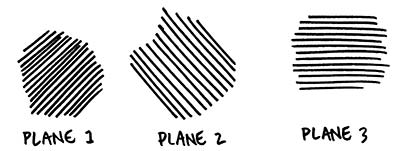
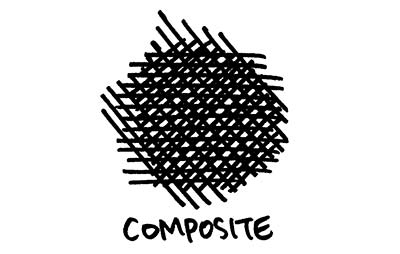
Crosshatching has an "old-fashioned" stigma, probably for good reason: drawing lines side-by-side, and then on top of each other, is a great solution to a problem inherent in pen & ink drawing and printmaking: How do you make a drawing tonal if all you have to work with is black and white?
With digital tools at our disposal, as well as relatively new products like Zipotone, Craftint and DuoShade, it's easy to see why crosshatching isn't considered cutting edge. However, I don't personally believe that a technique in itself can be old-fashioned; I think that comes out of how the artist uses the technique.
Below is a primer on crosshatching for the beginner or for those who want to hone their craft. Professionals -- we'd love to hear your advanced tips and tricks in the comments!
Styles of Crosshatching
1) Tight, accurate lines. Plane 2 is arranged at 90 degrees, plane 3 at 45 degrees.
2) Organic lines. Gives a softer feel.
3) Fast, wild lines. Energetic and frantic.
4) Lines that follow the contour of the surface.
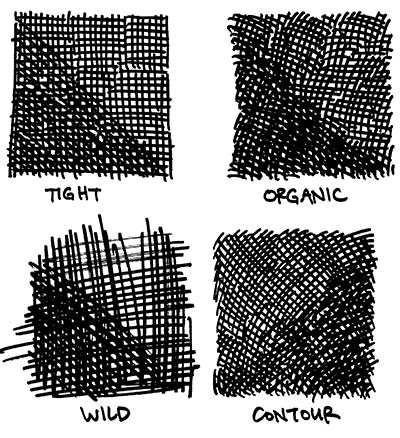
Moire Pattern
When an overlapping plane doesn't have much of directional shift from the plane below it, you can end up with an effect like below. It looks jarring and will take attention away from your drawing.
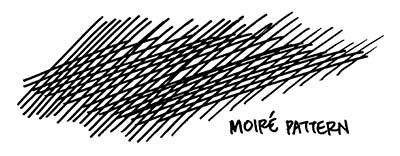
Contours
When drawing a 3D object like a skull, do you keep your lines straight or follow the contours of the object? Examples:
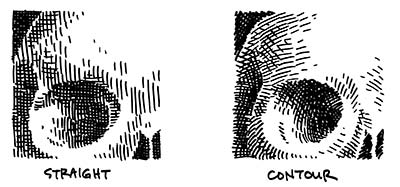
Gradients
Two kinds of gradients below. On the left, the planes of lines end abruptly, in chunks. On the right, however, there is a greater attempt to smooth the transistion through the use of small lines that "dissolve" from one plane into the next.

Consistency
There is no right way to crosshatch, but being consistent in whatever style you choose can go a long way towards making your work look competent.
Consistent line weight. Keeping a steady line is easier with an inflexible tip pen like a rapidograph. If you're using a flexible crow-quill nib, however, keeping steady line weight will be a chore.
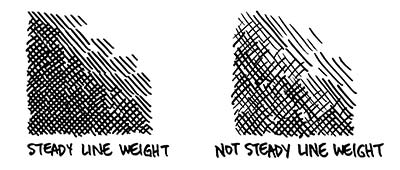
However, consistency and a changing line weight can go hand in hand, but takes concentration:
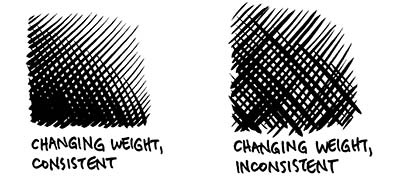

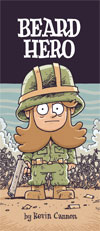
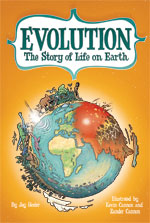
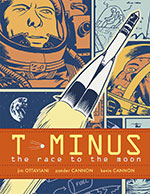
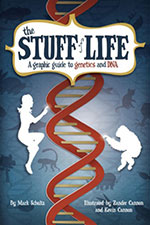
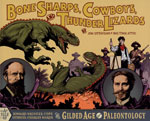
13 comments:
This is a great little tutorial. I just wish I could keep my line spacing consistent. I assume that just takes lots of practice.
Hi. Thanks for this tutorial. I've spent 4 years in art college but they didn't teach us how to do this =/
I didnt know about crosshatching till senior year in high school :)
but this is very helpful. And yes, it is a bit of work to keep spacing consistent. But at the same time, there is no "right way" of art style or form
for spacing consistency I have found it is more in the hand and less in the mind if that makes any sense.
yall are dumb. i learned cross hatching in elementary school. and for the person saying they spent 4 years in art school without knowing this...well, that means your probably never going to be any kind of artist and your school sucks. cross hatching is common sense, plain and simple.
Charles, you are a troll.
lol
Great Technique, and learned it few weeks back, tried some, but not completely cross hatching... take a look and give your critics pls
http://pencilandme.blogspot.com/2012/07/cross-hatching-technique.html
http://pencilandme.blogspot.in/2012/07/female-portrait-series-part-1.html
http://pencilandme.blogspot.in/2012/07/female-portrait-series-part-2.html
I've taken about 3 drawing classes and the teachers never really were able to teach me crosshatch. they couldn't demonstrate it either. When you cross hatch you have to break up the gradient image into blocks of shades in your mind. Then you can layer these blocks into the paper using consistent crosshatching.
After lots of practice I was able to create relatively good sketches: http://angelobonavera.com/
This tutorial is very interesting.. I never heard of wild crosshatching before. i also never knew there was only 3 planes for crosshatching.
www0417
san antonio spurs jerseys
nike air huarache
new orleans saints jerseys
jordan 4
nike roshe run
new england patriots jerseys
oakley sunglasses
coach factory outlet
oakley sunglasses wholesale
michael kors outlet
0816jejeLe nom de nike air jordan 1 retro high og chicago bulls marque Bathing Ape, dépendant de l'expression typique de votre langue adresse nike france saint ouen japonaise, «se baignant dans l'eau tiède», décrit asics gel lyte 3 beige moutarde la jeunesse du Japon pour suivre les traits blazer mid nike les plus actuels et les plus populaires. Certaines personnes air jordan 11 bg célèbres préfèrent même Air Drive Fusions. Méthodes nike air max thea premium net a porter de nettoyage de base est de faire usage sur le adidas zx flux femme noir blanc torchon avec un peu d'eau, puis essuyez doucement l'empeigne.
Clearly, It is an engaging article for us which you have provided here about watermark removal MacThis is a great resource to enhance knowledge about it. Thank you.
Só tem esses desenho de caveira como exemplo?
Post a Comment